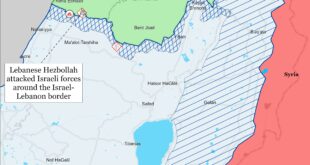The Islamic State (ISIS) jihadi group, which grew out of Al-Qaeda in Iraq during the first two decades of the 21st century and expanded into Syria following the outbreak of the ongoing civil war there, has remained an international jihadi militant organization despite the loss of its territory in Iraq and Syria.
By 2022, ISIS has declared 17 “provinces” throughout the Middle East, Asia, and Africa, and has claimed attacks in other countries in those regions. In the past, the organization had also masterminded attacks in Europe and the United States.
Although ISIS claimed no attacks in Western countries during 2022, many people linked to the organization were arrested for plotting attacks in those countries. In addition, pro-ISIS media groups continue to produce material inciting attacks in the West and threatening Western countries, while supporters of the organization still disseminate archival material by official and unofficial ISIS media encouraging “lone wolf” operations in those countries, albeit on a smaller scale than in the years preceding ISIS’ loss of territory in Iraq and Syria. Supporters also celebrate news of shootings, stabbings, and other attacks on Western non-Muslims, and express hope that the perpetrator will be revealed to have acted on behalf of ISIS.
ISIS’ operational tactics differ in these regions depending on factors such as military capabilities, the power of the local government, and presence of non-Sunni populations, although there are commonalities in its practices in all countries where it operates as an anti-government insurgency.
On November 30, ISIS released a speech by its official spokesman, Abu ‘Umar Al-Muhajir, acknowledging the death of its leader, Abu Al-Hasan Al-Hashemi Al-Qurashi, and announcing Abu Al-Husayn Al-Husayni Al-Qurashi as his successor. According to reports by the United Staes Central Command (US CENTCOM) and the media, it appears that the recently slain ISIS leader was an Iraqi named Nour Karim Al-Mutni aka Sayf Baghdad [The Sword of Baghdad], and that he was killed in mid-October in Jasem, in Syria’s Daraa Governorate, fighting former rebels who had reconciled with the Assad regime. In the message announcing a new ISIS caliph, the organization’s spokesman briefly mentioned the new leader’s somewhat vague goals of defending oppressed Muslims, implementing shari’a in all areas where ISIS enjoys “empowerment,” freeing imprisoned Muslims, and waging jihad against the “‘enemies of Allah.”
During 2022, ISIS has claimed attacks in at least 23 countries. The Islamic State West Africa Province (ISWAP), which operates in Nigeria, Cameroon, Chad, and eastern Niger; Islamic State Central Africa Province (ISCAP), operating in the Democratic Republic of the Congo (DRC); Mozambique Province; Sahel Province, operating in Mali, Burkina Faso, Benin, and western Niger; Libya province; and Sinai province have all claimed attacks this year in Africa, the continent which now experiences the most frequent and deadly attacks by ISIS affiliates. In Asia, the ISIS provinces in Syria, Iraq, Yemen, and Pakistan, as well as the Islamic State Khorasan Province (ISKP), active in Afghanistan and western Pakistan; India Province, active in Kashmir; and Islamic State East Asia Province (ISEAP), active in the Philippines, have claimed attacks during 2022.
ISIS has also claimed attacks in 2022 in Israel, Iran, Tajikistan, and Uzbekistan, none of which ISIS recognizes as provinces. However, the organization claimed no activity this year outside of Asia and Africa.
In general, it is possible to categorize countries where ISIS is active into:
- regions where its local affiliate is rising in power.
- regions where ISIS activity is steady.
- regions where ISIS activity is in decline.
The ISIS affiliates in Africa, particularly ISWAP, as well as ISCAP and its Mozambique and Sahel provinces, are growing more powerful and expanding their activities.
ISIS veteran provinces in Syria and Iraq remain active, despite their level of activity having declined from previous years.
The ISIS affiliate in Afghanistan remains significantly active, as does its affiliate in Pakistan, albeit on a smaller scale. Other provinces, such as those in Yemen, Libya, and the Philippines, have demonstrated relatively sparse activity in 2022 compared to previous years.
The ISIS India province, operating in Kashmir, claims infrequent, small-scale attacks, and has never been a formidable jihadi group. Likewise, the ISIS affiliate in Somalia is relatively inactive, although with apparently more operatives than the India Province.
There has recently been a marked decrease in the number of attacks claimed by ISIS. Since the beginning of August 2022, the organization has claimed between 20 to 30 weekly attacks worldwide, much fewer than its weekly average in earlier months. Since October 6, there has been no week in which ISIS claimed more than 30 total weekly attacks, and a low was reached during the weeks of October 28-November 3 and November 4-10, during which ISIS claimed only 15 and 14 total attacks, respectively.
 Eurasia Press & News
Eurasia Press & News



